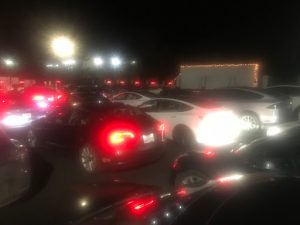 I was invited to an epic Christmas party in Pasadena. I was watching the weather all week, since a major storm was predicted and I feared that I-5 at Tejon Pass (“Grapevine Hill“) would have chain restrictions.
I was invited to an epic Christmas party in Pasadena. I was watching the weather all week, since a major storm was predicted and I feared that I-5 at Tejon Pass (“Grapevine Hill“) would have chain restrictions.
The trip down on Christmas day was uneventful, completed in a leisurely in 7 hours. There was a dusting of snow at the highest elevations, but it was merely scenic.
I had to return the day after Christmas (Boxing Day). The party had, indeed, been epic—as was the storm on Christmas night. I checked the Caltrans road conditions site and discovered that I-5 was closed, as were alternates such as SR-58 and SR-33. I shuddered, knowing that Thursday was supposed to be a major traffic day and that all the heavy traffic from 8-lane I-5 would be shunted onto an already-overloaded 4-lane US-101. I left for home at noon, about four hours earlier than I had planned, thinking that the trip could easily take twelve hours.
I wish.
Interestingly, though I-5 was clearly closed, Google Maps, Apple Maps, the usually awesome ABRP, and the Tesla navigator all tried to route me on I-5, cheerfully predicting a seven hour trek. They all need to get it together and pay attention to official road conditions, and not just their crowdsourced data.
I got on 101 and traffic was heavy but tolerable until about Thousand Oaks. I stopped for a quick Supercharge, got back on the freeway, and everything stopped. Five hours into the trip, I had gone less than 80 miles. My next charging stop was supposed to be Atascadero, and for the next two hours all the mapping software continued to report that it was 3-1/2 hours away.
I decided to stop at a Supercharger in Buellton, as the dense traffic made Atascadero a bit of a stretch. The other option was the San Luis Obispo Supercharger (at the Madonna Inn), but it is notoriously congested.
The scene at Buellton was a nightmare. The parking lot was packed with Teslas trying to get to the chargers. A Tesla employee was there trying to organize things. She told me there were 25 cars ahead of me, but I knew a lot of the people waiting didn’t know they needed to be on a list and the mood was getting ugly. It felt unsafe, with people grumbling and griping. I nope’d out of there and headed to SLO (which was reported as full, as was Atascadero).
I crawled to the SLO Supercharger and got there around 10pm. There were over 40 cars waiting, but there were two Tesla employees who had things very well organized. Tesla had brought in additional chargers on a flatbed, but they weren’t being used (presumably they had already been depleted). It took until 1:30am to get through the line and get charged, and I was once again on my way.
By then, it was kind of foggy but traffic was pretty light. On the other hand, I had been up since 5:30 in the morning, twenty hours, and though I find that it is remarkably easy to drive the Tesla without getting fatigued, it was getting to be too much. I was supposed to pick up Matthew and Joshua at 8am (they’d spent Christmas with their mother) and I didn’t want to be late, but when I started seeing double I decided that it was better to be an hour or two late than to wake up in a hospital (or not at all). All the rest areas were packed, with CHP officers waving people past. I stopped at a roadside motel at 3am and slept for over an hour, and got back on the road at 4:30. I charged again at a deserted Supercharger in Salinas (no waiting) and headed inland.
Around 7, I got off the road in San Ramon, called Joshua and Matthew to let them know they could just head home and I’d be there around 9:30. I got a bagel with egg and cheese and arrived home at 9:30am, 21 hours after I’d left for the usual 7-hour drive.
I know a lot of folks were pissed at Tesla for not having enough charging capacity. I tend to be a bit more charitable. For one, they’re aware that there isn’t sufficient capacity on the central coast, and I’ve heard that there’s a planned 35-stall V3 Supercharger station due to open in a few months. They also did the right thing, by sending staff and portable chargers to keep things safe, organized, and moving along. I have to say, though, that I was grateful that I was traveling alone. Most of the cars had families, and that must have been tough. More important is to understand that this was a truly unusual situation: AAA said that Thursday was the busiest auto travel day in recent history, and I-5 near Los Angeles doesn’t close very often. I suspect this storm set records, too. The trip may have taken 14 hours longer than expected, but only three of those hours were due to Supercharger congestion. Tesla might have been overwhelmed, but so was Caltrans. Many, many cars and trucks were on the side of the freeway to nap (and, doubtless, pee) and restaurants, gas stations, and rest areas were overwhelmed as well. In the end, it all turned out well with my main loss being missed sleep.
Thirty-six hours after it closed, Caltrans opened Tejon Pass to traffic on I-5 and the world was back to just normal fleeing-LA congestion.
The real take home lesson is to check road conditions rather than rely solely on route planning software (it would have added hours to my trip had I tried to take any of the routes suggested by Apple, Google, or Tesla), be prepared for inclement weather even in sunny Southern California (I always have lots of water, and my Pasadena hosts thoughtfully loaded me up with Christmas feast leftovers), be patient, defer travel if you possibly can, and take a break when you have to rather than drive when dangerously fatigued. (I felt silly paying $100 for an hour of bunk time, but it was my best decision of the trip.)
Oh, and even the old version 1 autopilot in my 2015 Tesla is transformative for long drives in stop-and-go traffic. Self-driving features are going to become much more common on all cars, and I can heartily recommend it.

